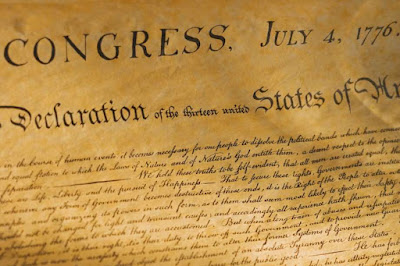July 4th - Declaration of Independence
We think of July 4, 1776, as a day that represents the Declaration of Independence and the birth of the United States of America as an independent nation. However,
• July 4, 1776 was not the day that the Continental Congress decided to declare independence. They actually did that on July 2, 1776.
• July 4, 1776, was not the day we started the American Revolution either. That had happened back in April 1775.
• July 4, 1776, was not the day Thomas Jefferson wrote the first draft of the Declaration of Independence. That was in June 1776.
• July 4, 1776, was not the date on which the Declaration was delivered to Great Britain. That didn’t happen until November 1776.
• July 4, 1776, was not the date the Declaration of Independence was signed. That was August 2, 1776.
So, what actually happened on July 4, 1776?
On July 4, 1776, the thirteen colonies claimed their independence from England, an event that eventually led to the formation of the United States.
Conflict between the colonies and England was already a year old when the colonies convened a Continental Congress in Philadelphia in the summer of 1776. In a June 7th session in the Pennsylvania State House (later Independence Hall), Richard Henry Lee of Virginia presented a resolution with the famous words:
“Resolved: That these United Colonies are, and of right ought to be, free and independent States, that they are absolved from all allegiance to the British Crown, and that all political connection between them and the State of Great Britain is, and ought to be, totally dissolved.”
Lee’s words were the springboard for the drafting of a formal Declaration of Independence, although the resolution was not followed up on immediately. On June 11th, consideration of the resolution was postponed by a vote of seven colonies to five, with New York abstaining. However, a Committee of Five was appointed to draft a statement presenting to the world the colonies’ case for independence. Members of the Committee included John Adams of Massachusetts, Roger Sherman of Connecticut, Benjamin Franklin of Pennsylvania, Robert R. Livingston of New York and Thomas Jefferson of Virginia. The task of drafting the actual document fell on Jefferson.
On July 1, 1776, the Continental Congress reconvened, and on the following day, the Lee resolution for independence was adopted by twelve of the thirteen colonies, New York not voting. Discussions of Jefferson’s Declaration of Independence resulted in some minor changes, but the spirit of the document was unchanged. The process of revision continued through all of July 3rd and into the late afternoon of July 4th. The Continental Congress approved the final wording of the Declaration of Independence on July 4, 1776. Of the thirteen colonies, nine voted in favor of the Declaration, two — Pennsylvania and South Carolina — voted no, Delaware was undecided and New York abstained. John Hancock, President of the Continental Congress, signed the Declaration of Independence. It is said that John Hancock signed his name “with a great flourish” so that England’s “King George could read it without spectacles!”
July 4, 1776, became the date that was included on the Declaration of Independence, and on the handwritten copy that was signed a month later in August. It was also the date that was printed on the Dunlap Broadsides, the original printed copies of the Declaration that were circulated throughout the new nation. So now, when people thought of the Declaration of Independence, July 4, 1776, was the date they remembered.
How did the Fourth of July become a national holiday?
For the first fifteen or twenty years after the Declaration of Independence was written, people didn’t celebrate it much at all. It was too new and there was too much going on in the young nation. By the 1790’s, the Declaration had become controversial. The Democratic-Republicans, admired Jefferson and the Declaration while the Federalists thought the Declaration was too French and too anti-British, which went against their current policies.
By 1817, John Adams complained in a letter that America seemed uninterested in its past, but that would soon change.
After the War of 1812, the Federalist Party began to come apart and the new parties of the 1820’s and 1830’s all considered themselves inheritors of Jefferson and the Democratic-Republicans. Printed copies of the Declaration began to circulate again, all with the date July 4, 1776, listed at the top. The deaths of Thomas Jefferson and John Adams on July 4, 1826, may have helped to promote the idea of July 4th as an important date to be celebrated.
Celebrations of the Fourth of July became more common as the years went on. In 1870, almost a hundred years after the Declaration was written, Congress declared July 4th to be a national holiday as part of a bill to officially recognize several holidays, including Christmas. Further legislation about national holidays, including July 4th, was passed in 1939 and 1941.
Article shared from military.com/constitutionfacts.com
Have a great Holiday!
All the best,
~Craig
Want more?! Become a better Protector. Learn how to protect yourself and others more effectively with my free home study course: https://sixdaydefense.com/




Comments
Post a Comment